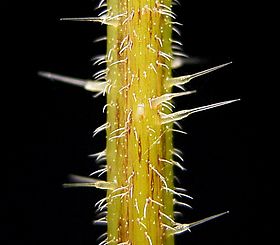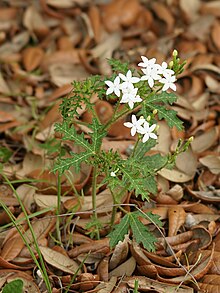Stinging plant

Astinging plantor aplant with stinging hairsis a plant with hairs (trichomes) on its leaves or stems that are capable of injecting substances that cause pain or irritation.
Other plants, such asopuntias,have hairs or spines that cause mechanical irritation, but do not inject chemicals. Stinging hairs occur particularly in thefamiliesUrticaceae,Loasaceae,Boraginaceae (subfamilyHydrophylloideae) andEuphorbiaceae.[1]Such hairs have been shown to deter grazing mammals, but are no more effective against insect attack than non-stinging hairs.[2]Many plants with stinging hairs have the word "nettle" in their English name, but may not be related to "true nettles" (thegenusUrtica).
Though several unrelated families of plants have stinging hairs, their structure is generally similar. A solid base supports a single elongated cell with a brittle tip. When the tip is broken, the exposed sharp point penetrates the skin and pressure injects toxins. The precise chemicals involved in causing pain and irritation are not yet fully understood.
Structure and function of stinging hairs
[edit]
Stiff hairs ortrichomeswithout the ability to inject irritating compounds occur on the leaves and stems of many plants. They appear to deter feeding insects to some degree by impeding movement and restricting access to the surface of the stem or leaf. Some plants have glandular hairs, either as well as non-glandular hairs or instead of them. Glandular hairs have regions of tissue that produce secretions of secondary metabolites. These chemical substances can repel or poison feeding insects.[3]

Stinging hairs may be defined as those with ability to inject a chemical substance through the skin of an animal causing irritation or pain. Since some glandular hairs can cause irritation merely by contact, the difference between "stinging hairs" and "irritating hairs" is not always clear. For example, the hairs ofMucunaspecies are described in both ways. Some species ofMucunahave sharply tipped hairs, in which the upper part easily breaks off, whereas other species have hairs that are blunter.[4]In those subspecies ofUrtica dioicathat have stinging hairs (stinging nettles), these also have a point that easily breaks off, allowing the irritants in the cell below to enter through the skin.[5]Being stung in this way has been shown to deter grazing mammals, such as rabbits,[6]and even large herbivores such as cows.[3]Many plant species respond to physical damage by producing a higher density of trichomes of all kinds.[3]
The general structure of a stinging hair is very similar in all the families of plants that possess them (exceptTragiaandDalechampia). A multicellular base supports a single long thin cell, typically 1–8 mm long, with a brittle tip that easily breaks to form a sharp point that can penetrate skin.[7]Stinging hairs ofUrticaspecies have been studied in some detail. Each hair contains a fine tube, stiffened withcalcium carbonate(calcified) at its base and withsilica(silicified) at its tip. InUrtica thunbergiana,individual hairs contain around 4 nanolitres (4×10−6ml) of fluid. The silicified tip breaks off on contact, and the resulting fine point pierces the skin. Pressure forces the fluid out of the hair.[8]
Different toxins may be involved. The stinging hairs ofTragiaspp, notablyTragia volubilis,a South American member of theEuphorbiaceae,are capable of injecting a crystal ofcalcium oxalate.[9]The stinging sensation is initially caused by the mechanical entry of the stiff hair into the skin, but is then intensified by the effect of the oxalate.[10]
| Toxin | Concentration |
|---|---|
| Histamine | 0.53% |
| Tartaric acid | 1.44% |
| Oxalic acid | 0.12% |
The effects of the stinging hairs ofUrticaspecies, particularly some subspecies ofUrtica dioica,have been attributed to a number of substances, includinghistamine,acetylcholine,serotonin,[10]andformic acid.[8]Histamine is a component of the stinging hairs of otherUrticaspecies (e.g.U. urensandU. parviflora) and ofCnidoscolus urensandLaporteaspecies. Invertebrates,histamine is aneurotransmitter.When it is released naturally, inflammation of the skin results, causing pain and itching. Injection of histamine by stinging hairs has been considered to have the same effect.[5]
This traditional interpretation was challenged in 2006 by research onUrtica thunbergiana,the main species ofUrticapresent inTaiwan.In tests on rats, the long-lasting pain caused by stings was attributed tooxalicandtartaric acid,although a synergistic effect of the other components of the stinging hairs was not ruled out. Fu et al. concluded that "stinging hairs, although studied for a long time, are still mysterious, particularly concerning the mechanism of the skin reaction after being stung."[8]
Plants with stinging hairs
[edit]Urtica
[edit]Many plants with stinging hairs belong to the genusUrtica.Between twenty-four and thirty-nine species of flowering plants of the genusUrticain the familyUrticaceaefall into this category, with acosmopolitanthough mainly temperate distribution. They are mostlyherbaceousperennial plants,but some areannualand a few areshrubby.The most prominent member of the genusUrticais thestinging nettle,Urtica dioica,native toEurope,Africa,Asia,andNorth America.[citation needed]
Other Urticaceae
[edit]The family Urticaceae also contains some other plants with stinging hairs that are not members of the genusUrtica.These include:

- Dendrocnidespp.
- Dendrocnide excelsa(giant stinging tree)
- Dendrocnide moroides(gympie-gympie)
- Dendrocnide peltata(stinging tree,jelaton)
- Girardinia diversifolia(synonym:G. leschenaultiana) (Nilgiri nettle, Himalayan giant nettle), source of allo fibre
- Laportea canadensis(wood nettle)
- Ureraspp.
- Urera baccifera(nettle tree)
- Urera tenax
Other families
[edit]There are also plants with stinging hairs that are unrelated to the Urticaceae:[11]

- Boraginaceae: Hydrophylloideae
- Phacelia malvifolia(stinging phacelia)[12]
- Wigandiaspp.[13]
- Euphorbiaceae
- Cnidoscolusspp.
- Cnidoscolus stimulosus(bull nettle or spurge nettle)
- Cnidoscolus urens(stinging spurge or mala mujer)
- Croton ciliato-glandulosus(ciega-vista)
- Dalechampiaspp.[13]
- Tragiaspp. (noseburn)
- Cnidoscolusspp.
- Fabaceae
- Mucunaspp.
- Mucuna pruriens(cowhage)
- Mucunaspp.
- Loasaceae[14]
- Solanaceae
- Solanum carolinense(Carolina horsenettle)[citation needed]
Toxicity
[edit]
Though plants with stinging hairs can cause pain and acuteurticaria,only a few are seriously harmful. The genusDendrocnide(stinging trees) has been said to cause the most pain, particularly the AustralianDendrocnide moroides(gympie-gympie), although other sources[15]describe the pain of stinging trees as only differing from that of nettles in terms of persistence rather than severity. There are reports of dogs and horses being killed, and once of a human death.[citation needed]The researcher Marina Hurley reports being hospitalized after being stung by a dead leaf. Deaths are probably due to heart failure caused by pain and shock.[16]Urtica ferox(tree nettle or ongaonga) isendemictoNew Zealand.One recorded human death is known: a lightly clad young man died five hours after walking through a dense patch.[17]
After cooking, some plants with stinging hairs, such asUrtica dioica(stinging nettle), are eaten as vegetables.[18]
References
[edit]- ^Lookadoo, S.E. & Pollard, A.J. Pollard (1991), "Chemical contents of stinging trichomes ofCnidoscolus texanus",Journal of Chemical Ecology,17(9): 1909–1916,doi:10.1007/bf00993737,PMID24257929,S2CID20594828
- ^"Plant Resistance against Herbivory | Learn Science at Scitable".www.nature.com.Retrieved2023-03-10.
- ^abcDalin, Peter; Ågren, Jon; Björkman, Christer; Huttunen, Piritta & Kärkkäinen, Katri (2008), "Leaf trichome formation and plant resistance to herbivory", in Schaller, Andreas (ed.),Induced plant resistance to herbivory,Springer, pp. 89–105,doi:10.1007/978-1-4020-8182-8_4,ISBN978-1-4020-8181-1
- ^Aminah, S.H.; Sastrapradja, S.; Lubis, I.; Sastrapradja, D. & Idris, S. Idris (1974),"Irritant hairs ofMucunaspecies "(PDF),Annales Bogorienses,179:186,retrieved2013-08-17
- ^abWink, Michael (1997), "Special Nitrogen Metabolism", in Dey, P.M. & Harborne, J.B. (eds.),Plant Biochemistry(PDF),Academic Press, pp. 439–485,ISBN978-0-12-214674-9,retrieved2013-08-17
- ^Pollard, A. Joseph (1992), "The Importance of Deterrence: Responses of Grazing Animals to Plant Variation", in Fritz, Robert S. & Simms, Ellen L. (eds.),Plant Resistance to Herbivores and Pathogens: Ecology, Evolution, and Genetics,pp. 216–239,ISBN978-0-226-26553-7,retrieved2013-08-16
- ^Pollard 1992,pp. 227–228.
- ^abcdFu, H.Y.; Chen, S.J.; Chen, R.F.; Ding, W.H.; Kuo-Huang, L.L. & Huang, R.N. (2006), "Identification of oxalic acid and tartaric acid as major persistent pain-inducing toxins in the stinging hairs of the nettle,Urtica thunbergiana",Annals of Botany,98(1): 57–65,doi:10.1093/aob/mcl089,PMC2803540,PMID16675601
- ^Duarte-Casar, Rodrigo; Romero-Benavides, Juan Carlos (December 2021)."Tragia L. Genus: Ethnopharmacological Use, Phytochemical Composition and Biological Activity".Plants.10(12): 2717.doi:10.3390/plants10122717.ISSN2223-7747.PMC8705345.PMID34961188.
- ^abArmstrong, W.P.,"Plants With Stinging Trichomes",Wayne's Word,Palomar College,retrieved2013-08-16
- ^Rohde, M. (1988–2006),Guide to Contact-Poisonous Plants,mic-ro.com,retrieved2010-02-12
- ^"Hydrophyllaceae (Waterleaf Family)",Native Plants of Montara Mountain,retrieved2013-08-17
- ^abcPollard 1992,p. 227.
- ^"Loasaceae",Encyclopædia Britannica Online,retrieved2013-08-17
- ^T. Crowley, A New Bislama Dictionary, p. 335
- ^Hurley, Marina (2000),"Selective stingers",ECOS Magazine(105): 18–23,retrieved2013-08-17
- ^"Poisonous native plants",Te Ara Encyclopedia of New Zealand,retrieved2013-08-17
- ^"Nettle Recipes Mariquita Farm".
